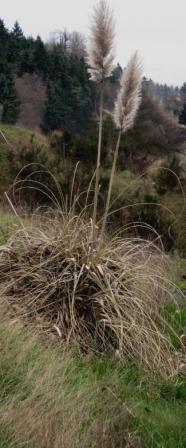

Here’s a photo of some pampas grass (Cortaderia selloana), much beloved by many homeowners in their landscapes:

But what’s unusual – and undesirable – about this particular specimen? Hint: the landscape has been modified a little.
Answer on Monday!


Published by

Linda Chalker-Scott
Dr. Linda Chalker-Scott has a Ph.D. in Horticulture from Oregon State University and is an ISA certified arborist and an ASCA consulting arborist. She is WSU’s Extension Urban Horticulturist and a Professor in the Department of Horticulture, and holds two affiliate associate professor positions at University of Washington. She conducts research in applied plant and soil sciences, publishing the results in scientific articles and university Extension fact sheets.
Linda also is the award-winning author of five books: the horticultural myth-busting The Informed Gardener (2008) and The Informed Gardener Blooms Again (2010) from the University of Washington Press and Sustainable Landscapes and Gardens: Good Science – Practical Application (2009) from GFG Publishing, Inc., and How Plants Work: The Science Behind the Amazing Things Plants Do from Timber Press (2015). Her latest effort is an update of Art Kruckeberg’s Gardening with Native Plants of the Pacific Northwest from UW Press (2019).
In 2018 Linda was featured in a video series – The Science of Gardening – produced by The Great Courses. She also is one of the Garden Professors – a group of academic colleagues who educate and entertain through their blog and Facebook pages. Linda’s contribution to gardeners was recognized in 2017 by the Association for Garden Communicators as the first recipient of their Cynthia Westcott Scientific Writing Award.
"The Garden Professors" Facebook page - www.facebook.com/TheGardenProfessors
"The Garden Professors" Facebook group - www.facebook.com/groups/GardenProfessors
Books: http://www.sustainablelandscapesandgardens.com
View all posts by Linda Chalker-Scott

Razor-sharp grass blades.
It has escaped the homeowners landscape.
Usually these posts are much more puzzling to me. I looked at the image and before I read the text my brain said “that’s feral pampas grass.” It grows all over the place in California as an invasive weed.
Has it been sprayed in an attempt to kill it, which obviously hasn’t worked, and is now not likely to work again due its current sickly state? It’s my experience with pampas that unless you thoroughly kill it with a spray the first time, the plant continues growing in a sickly state, which makes it virtually impossible to kill with herbicides in the future (i.e. spraying unhealthy plants with herbicide will often not kill them as they do not ‘take it up’ as readily as healthy plants do).
Massively invasive. I used to live in California where it would take over whole roadsides.
Hmmm – well, it is invasive, but that’s not unusual. It’s half dead – did it get sprayed with herbicide & still not die completely ? Or is it that it’s smack in the middle of a restoration meadow ? Or … perhaps it’s in the middle of a wilderness area (evergreens in the background + the obvious slope = limited access mountains in my area), far removed from its parent ?
I’m sure the answer will be obvious once we have it, but those are the thoughts that come to my untrained eye.
By the slope, it looks like it might have inserted itself in a green roof.